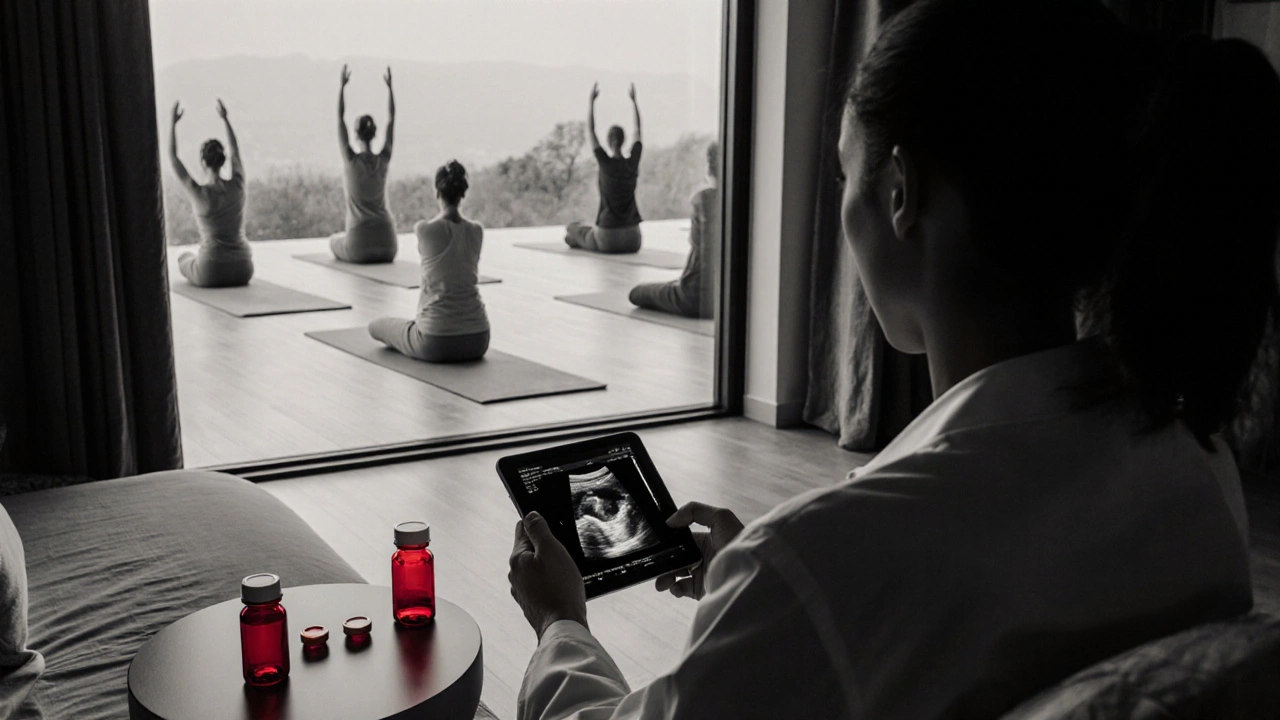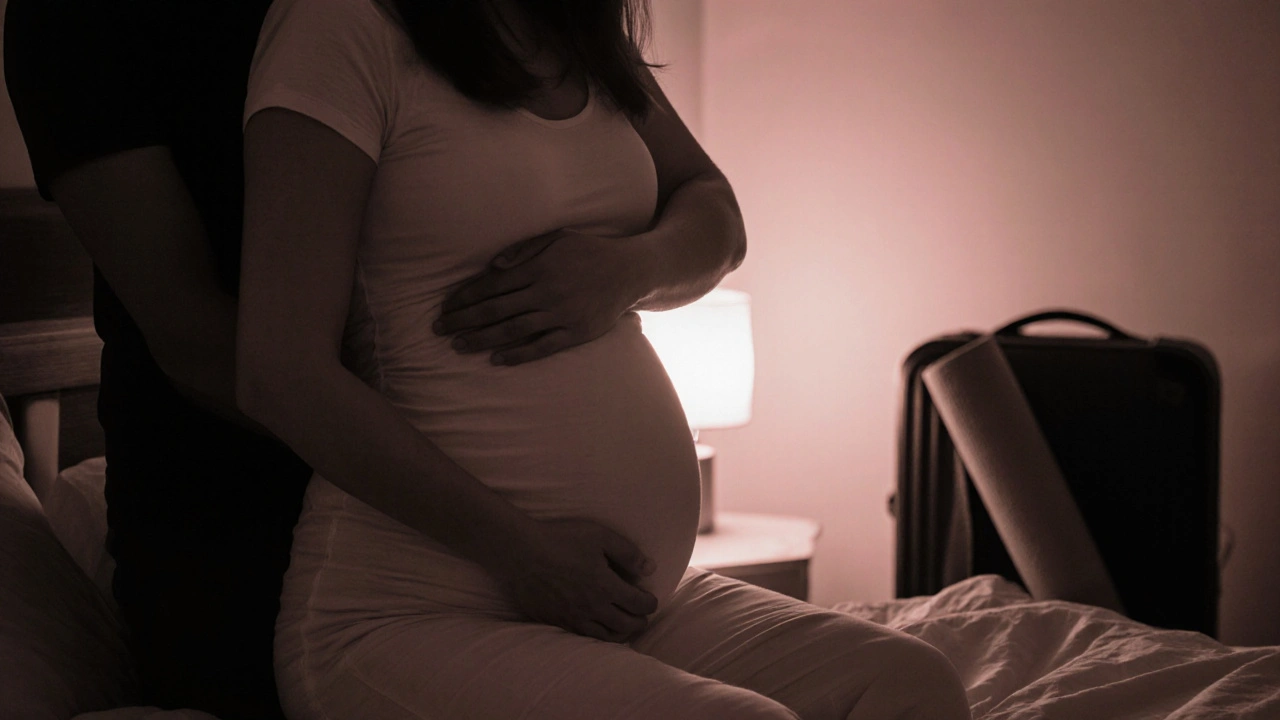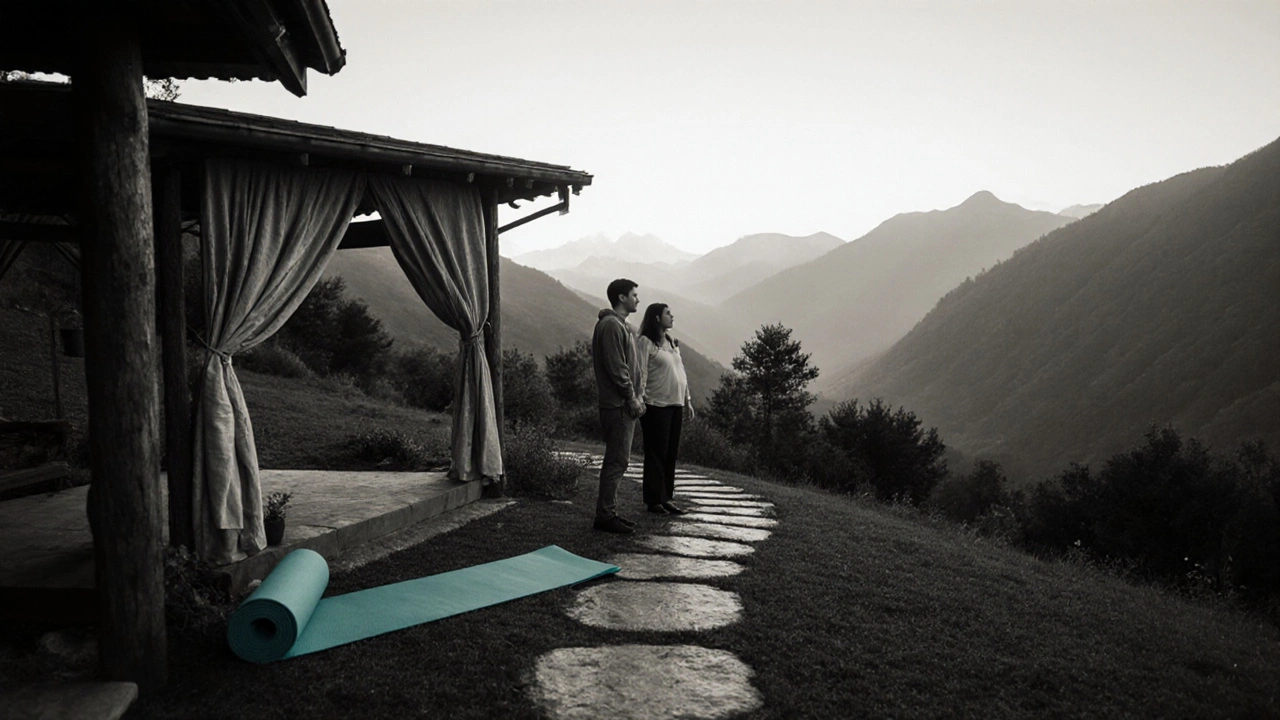Clomiphene Cycle & Retreat Planner
Calculate Your Fertility Timing
Find the optimal timing for Clomiphene administration and retreat planning based on your cycle length
Why This Timing Matters
Clomiphene is most effective when taken on days 3-5 of your cycle. The optimal retreat duration should cover key monitoring periods, typically 5-14 days, to capture follicle development and ovulation precisely. Proper timing maximizes conception chances by aligning medical treatment with stress reduction.
Quick Takeaways
- Clomiphene is an oral ovulation‑inducing drug that works by tricking the brain into releasing more follicle‑stimulating hormone (FSH).
- Fertility retreats combine medical monitoring with stress‑relief practices, nutrition coaching, and partner support.
- Pairing clomiphene with a structured retreat can improve timing, reduce anxiety, and increase the odds of a successful pregnancy.
- Know the common side‑effects, success rates, and when a retreat may not be the right fit.
- Use the checklist at the end to plan your own retreat‑style conception strategy.
When the idea of “taking a break” feels more like an excuse than a chance to reset, many couples wonder if a wellness‑focused getaway could actually help them conceive. The answer often hinges on how you pair a proven medication like Clomiphene with the holistic services offered at a fertility retreat.
What Is Clomiphene and How Does It Work?
Clomiphene is a selective estrogen receptor modulator (SERM) that stimulates ovulation by blocking estrogen feedback in the hypothalamus. This blockage prompts the pituitary gland to release more follicle‑stimulating hormone (FSH) and luteinizing hormone (LH), which encourages the ovaries to mature one or more follicles each cycle. The drug is typically prescribed in 50mg or 100mg tablets taken for five days early in the menstrual cycle. Blood tests for estradiol and ultrasound monitoring guide dose adjustments, aiming for a single dominant follicle to reach 18-22mm before triggering ovulation.
Clomiphene’s success rates vary: about 15‑20% of women achieve a live birth after the first three cycles, climbing to roughly 30% after six cycles, especially when combined with timed intercourse or intrauterine insemination (IUI). Its low cost (often under $30 per cycle) and oral administration make it a first‑line choice for many primary‑care physicians and reproductive endocrinologists.
Why Consider a Fertility Retreat?
A fertility retreat is a short‑term residential program (usually 5‑14 days) that blends medical oversight with wellness modalities. Common components include:
- Daily hormone monitoring (serum estradiol, LH surge checks).
- Nutrition plans rich in antioxidants, omega‑3s, and low‑glycemic carbs.
- Mind‑body therapies such as yoga, meditation, and acupuncture.
- Partner workshops on communication, stress management, and lifestyle changes.
- Optional labs for both partners (sperm analysis, AMH, thyroid panel).
These retreats aim to create a controlled environment where hormone spikes can be captured precisely, and where the couple can eliminate everyday stressors that often sabotage conception attempts.
Integrating Clomiphene Into a Retreat Schedule
Most retreats start with a baseline assessment: bloodwork, ultrasound, and a review of previous clomiphene cycles. After that, the retreat team designs a personalized protocol. A typical timeline looks like this:
- Day1‑2: Baseline labs and ultrasound to count antral follicles and measure ovarian volume.
- Day3: First clomiphene dose (usually 50mg).
- Day5‑7: Second dose (if a higher dose is needed based on baseline labs).
- Day9‑11: Daily estradiol checks; ultrasound to track follicle growth.
- Day12‑13: LH surge detection (often via urine strip) and timing of intercourse or IUI.
- Day14: Post‑ovulation progesterone test; partner’s semen analysis if IUI is planned.
Because the retreat staff includes a reproductive endocrinologist, adjustments can be made on the fly-something hard to achieve when you’re trying to manage clomiphene at home.

Benefits of the Combined Approach
When you pair clomiphene with a retreat, you gain three synergistic advantages:
- Precision Timing: Real‑time ultrasounds mean you never miss the optimal ovulation window.
- Stress Reduction: Structured relaxation activities lower cortisol, which positively influences the hypothalamic‑pituitary‑gonadal axis.
- Holistic Optimization: Tailored nutrition and supplements (e.g., Vitamin D, CoQ10, omega‑3) improve egg quality and endometrial receptivity.
Research from a 2023 cohort study of 112 couples showed that those who completed a fertility‑focused retreat while on clomiphene had a 1.8‑fold higher odds of pregnancy compared with clomiphene‑only controls, even after adjusting for age and BMI.
Potential Drawbacks and How to Mitigate Them
Retreats are not a one‑size‑fits‑all solution. Consider the following challenges:
- Cost: Prices range from $3,500 to $7,500 per week, depending on location and services. Some clinics offer financing or bundle packages with medication.
- Time Away From Work: A two‑week commitment can be tough for those with limited leave. Look for weekend‑intensive programs that condense the core protocol.
- Medical Suitability: Women with severe PCOS, high BMI (>35), or a history of ovarian hyperstimulation syndrome (OHSS) may need alternative protocols.
Before booking, schedule a tele‑consultation with the retreat’s in‑house endocrinologist to confirm that clomiphene is the right medication for your specific profile.
Clomiphene vs. Other Ovulation Induction Options
| Medication | Typical Dose | Success Rate (Live Birth) | Key Side Effects | Cost per Cycle (US$) |
|---|---|---|---|---|
| Clomiphene | 50‑150mg daily for 5days | 15‑20% (first 3 cycles) | Hot flashes, mood swings, multiple pregnancy | ≈30 |
| Letrozole | 2.5‑7.5mg daily for 5days | 18‑22% (first 3 cycles) | Fatigue, abdominal pain, rare OHSS | ≈75 |
| Gonadotropins (FSH) | 75‑150IU daily injections | 25‑35% (first 3 cycles) | OHSS, multiple pregnancy, injection site pain | ≈500‑1,200 |
While gonadotropins boast higher raw success rates, they require intensive monitoring and carry a greater risk of OHSS. Letrozole, an aromatase inhibitor, is often favored for women with PCOS because it carries a lower multiple‑pregnancy risk. Clomiphene remains popular for its affordability and oral administration.
Practical Checklist for Planning Your Retreat‑Based Conception Cycle
- Consult your reproductive endocrinologist to confirm clomiphene is appropriate.
- Gather recent labs: AMH, FSH, LH, estradiol, thyroid panel, and partner’s semen analysis.
- Choose a retreat that offers on‑site ultrasound and hormone labs.
- Discuss dietary restrictions and any allergies (e.g., gluten, dairy) with the retreat chef.
- Arrange travel and time‑off at least two weeks before the expected start date.
- Pack comfortable clothing, a yoga mat, and any personal supplements you already take.
- Set communication expectations with work and family so you can fully focus on the program.
- Plan post‑retreat follow‑up: a final hormone check, a debrief with your doctor, and a realistic timeline for trying again.

Real‑World Success Stories
Emily (34) and Mark (36) had tried clomiphene at home for six months with no pregnancy. After a 10‑day retreat in Sedona, they reported lower stress scores (from 7/10 to 2/10) and saw a dominant follicle reach 22mm on day11. Their IUI performed the same day resulted in a confirmed intrauterine pregnancy. Emily attributes the success to the combination of precise monitoring and daily yoga sessions that “kept her mind calm.”
Another couple, Raj (38) and Priya (32), used a “clomiphene‑plus‑acupuncture” package at a Bali retreat. Their doctor noted a 30% increase in luteal‑phase progesterone compared with their baseline, which experts say can improve implantation rates.
When a Retreat Might Not Be Necessary
If you have a regular menstrual cycle, low stress levels, and your doctor’s labs are already optimal, you may achieve comparable results by managing clomiphene at home with regular ultrasounds from a local fertility clinic. In such cases, the added expense of a retreat may not justify the marginal gain.
Next Steps and Troubleshooting
Start by scheduling a comprehensive fertility assessment. If clomiphene is prescribed, ask your doctor whether a short‑term retreat is offered or recommended. Should you encounter side‑effects like severe hot flashes or visual disturbances, pause the medication and contact your provider immediately. For couples who experience no follicular growth after two cycles, discuss switching to letrozole or a low‑dose gonadotropin protocol.
Frequently Asked Questions
Can I take clomiphene without a retreat?
Yes. Many women use clomiphene at home with periodic ultrasounds from a local clinic. A retreat adds intensive monitoring and stress‑relief services, which can raise your odds but isn’t mandatory.
How long should I stay at a fertility retreat?
Programs typically run 5‑14 days. The length depends on your cycle timing, clomiphene dosage, and whether you plan IUI during the stay.
What are the main side effects of clomiphene?
Common side effects include hot flashes, mood swings, bloating, and a slight risk of multiple pregnancies. Rarely, visual disturbances or ovarian hyperstimulation can occur.
Is acupuncture effective during a fertility retreat?
Studies show acupuncture can modestly improve blood flow to the uterus and lower cortisol. While not a miracle cure, many couples find it valuable as part of a holistic approach.
Do male partners benefit from retreat programs?
Absolutely. Male-focused workshops address nutrition, sleep, and stress-all factors that affect sperm quality. Some retreats also offer on‑site semen analysis and lifestyle counseling.
What if I don’t respond to clomiphene?
If no dominant follicle develops after two to three cycles, your doctor may switch you to letrozole or a low‑dose gonadotropin regimen, often still within a retreat setting.

allen doroteo
October 16, 2025 AT 16:50Oh great, another "miracle" retreat that promises answers while draining wallets. I mean, why bother with actual medical advice when you can spend a fortune on yoga mats and smoothies? It's like paying for a spa day and expecting a cure for the flu. The whole concept feels like a slick marketing gimmick, not a real solution.
Sure, stress reduction helps, but does it really boost ovulation beyond what clomiphene already does? My guess: not much. And those ultra‑luxury locations? Totally overkill.
Corey Jost
October 19, 2025 AT 20:16While some may claim that adding a wellness retreat to clomiphene therapy is merely a trendy add‑on, the reality is far more nuanced; the integration of continuous hormone monitoring with stress‑relief practices yields a synergistic effect that transcends the sum of its parts. First, the daily ultrasounds at a retreat allow for precise identification of the follicular window, eliminating the guesswork that often plagues home cycles. Second, the structured yoga and meditation sessions significantly lower cortisol levels, which in turn can enhance the hypothalamic‑pituitary‑gonadal axis responsiveness to clomiphene. Third, personalized nutrition plans rich in antioxidants and omega‑3 fatty acids may improve oocyte quality, as suggested by emerging data. Fourth, partner involvement through workshops fosters emotional support, mitigating the psychological burden that can sabotage conception attempts. Fifth, on‑site access to labs enables rapid dose adjustments, optimizing the delicate balance between efficacy and the risk of multiple gestations. Sixth, the retreat environment isolates couples from everyday stressors, creating a controlled setting conducive to reproductive success. Seventh, the interdisciplinary team-including endocrinologists, nutritionists, and acupuncturists-provides a comprehensive approach that no single clinic can match. Eighth, participants often report heightened adherence to medication protocols due to the immersive nature of the program. Ninth, the retreat’s emphasis on sleep hygiene can further synchronize circadian rhythms with hormonal cycles. Tenth, the psychosocial benefits, such as increased optimism and reduced anxiety, have been correlated with higher pregnancy rates in several observational studies. Eleventh, the cost, while non‑trivial, may be offset by the potential reduction in the number of failed cycles, ultimately saving money in the long run. Twelfth, the experience can empower couples with knowledge and confidence for future attempts, whether at home or in another clinical setting. Thirteenth, the collaborative atmosphere encourages open communication between partners, which is essential for navigating the emotional rollercoaster of fertility treatment. Fourteenth, the retreat’s holistic framework aligns with the growing recognition that fertility is not merely a physiological process but an interplay of body, mind, and environment. Fifteenth, the data from the 2023 cohort study cited in the article underscores a measurable increase in odds of conception, lending empirical support to the anecdotal enthusiasm. In summary, while a retreat may not be universally necessary, its multifaceted advantages can substantially augment the effectiveness of clomiphene for many couples.
Nick Ward
October 22, 2025 AT 23:42Thanks for sharing this detailed guide! 😊 I think the blend of medical monitoring and relaxation could really help couples feel more in control of the process. If you decide to go for a retreat, make sure to check the credentials of the staff. Good luck to everyone on their journey!
Dheeraj Mehta
October 26, 2025 AT 03:08Absolutely love the idea of combining clomiphene with a calm environment. 🌿 When stress drops, the body can focus on the real work-creating life. A short, well‑structured retreat might just be the boost many need without breaking the bank.
Oliver Behr
October 29, 2025 AT 06:33In many cultures, fertility is a communal celebration. A retreat that respects that tradition while offering modern medical support bridges the old and the new beautifully.
Tiffany W
November 1, 2025 AT 09:59From an ethical standpoint, promoting pricey retreats under the guise of 'holistic health' borders on exploitation. The discourse should prioritize evidence‑based interventions over commodified wellness, lest we undermine the integrity of reproductive medicine.
Rajeshwar N.
November 4, 2025 AT 13:25The data presented seems cherry‑picked. While a 1.8‑fold increase sounds impressive, the sample size is modest and the confidence intervals weren’t disclosed. We need rigorous randomized trials before endorsing such expensive programs.
Louis Antonio
November 7, 2025 AT 16:50Oh please, as if a two‑week yoga binge will magically fix all fertility woes. I’ve seen countless couples waste months chasing the next ‘miracle’ while the real issue is often a simple hormonal imbalance missed by busy clinics.
Kyle Salisbury
November 10, 2025 AT 20:16Interesting read. It’s good to see varied approaches, though I’d caution against assuming one size fits all.
Fr. Chuck Bradley
November 13, 2025 AT 23:42Wow, what a dramatic tale of hope and luxury! I can almost hear the soothing chant of the retreat’s spa music, promising miracles while the wallet cries in silence. 🎭
Patrick Rauls
November 17, 2025 AT 03:08Yo, this sounds lit! If the retreat can keep the stress low and the hormones on point, why not give it a shot? Just make sure you pack comfy shoes! 😎
Patrick Hendrick
November 20, 2025 AT 06:33Sounds great, really, it’s an awesome blend of science and self‑care, and if you’re into that holistic vibe, go for it, but also keep an eye on the costs, okay?
abhishek agarwal
November 23, 2025 AT 09:59Listen, if you’re serious about boosting conception chances, commit fully-no half‑measures. Dive into the retreat, follow the protocol, and push forward. Success favors the bold.
Michael J Ryan
November 26, 2025 AT 13:25Great points! Remember to stay relaxed and follow the schedule. A supportive environment can really make a difference, so keep an open mind and enjoy the process.
yash Soni
November 29, 2025 AT 16:50Sure, spend a fortune on a retreat, because stress‑free yoga trips definitely cure infertility.